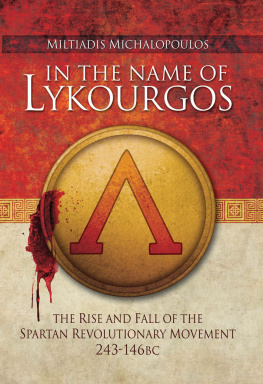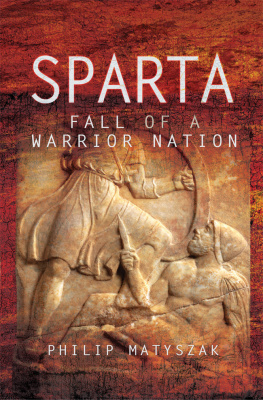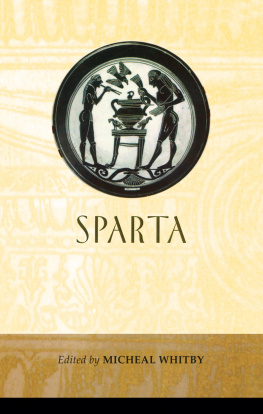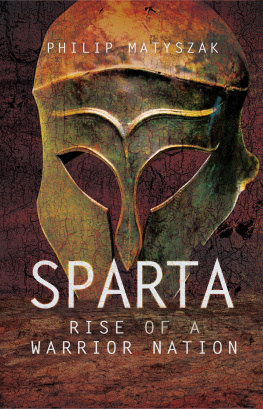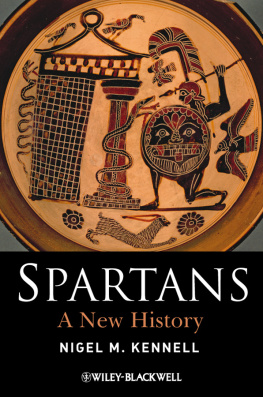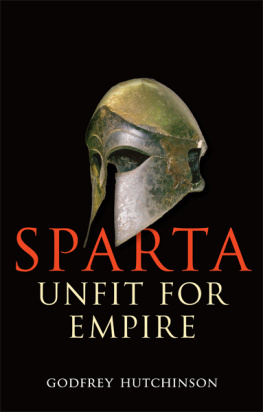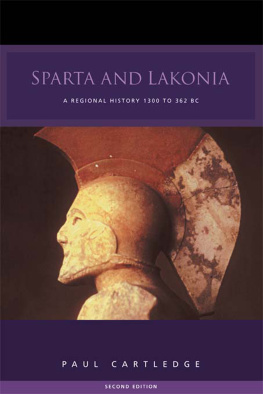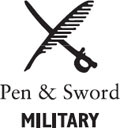
In the Name of Lykourgos
To Marion
In the Name of Lykourgos
The Rise and Fall of the Spartan Revolutionary Movement (243146 BC )
Miltiadis Michalopoulos
Translated by Marion Kavallieros and Maria Anna Niforos
First published in Great Britain in 2016 by
Pen & Sword Military
an imprint of
Pen & Sword Books Ltd
47 Church Street
Barnsley
South Yorkshire
S70 2AS
Copyright Miltiadis Michalopoulos 2016
ISBN 978 1 78303 023 1
eISBN 978 1 47388 429 8
Mobi ISBN 978 1 47388 428 1
The right of Miltiadis Michalopoulos to be identified as the Author of this Work has been asserted by him in accordance with the Copyright, Designs and Patents Act 1988.
A CIP catalogue record for this book is available from the British Library
All rights reserved. No part of this book may be reproduced or transmitted in any form or by any means, electronic or mechanical including photocopying, recording or by any information storage and retrieval system, without permission from the Publisher in writing.
Pen & Sword Books Ltd incorporates the imprints of Pen & Sword Archaeology, Atlas, Aviation, Battleground, Discovery, Family History, History, Maritime, Military, Naval, Politics, Railways, Select, Transport, True Crime, and Fiction, Frontline Books, Leo Cooper, Praetorian Press, Seaforth Publishing and Wharncliffe.
For a complete list of Pen & Sword titles please contact
PEN & SWORD BOOKS LIMITED
47 Church Street, Barnsley, South Yorkshire, S70 2AS, England
E-mail:
Website: www.pen-and-sword.co.uk
List of Plates
Lykourgos
Kleombrotos is banished by King Leonidas
Kleomenes III silver tetradrachm
The Sellasia Battlefield
Evas Hill
Olympos Hill
Menelaion
Olbiadas in war
Nabis silver tetradrachm
List of Maps
The Peleponese 229
Accesses to Lakonia
Kleomenic War: The first phase
The Cities of Achaea
Kleomenic War: The second phase
The Corinthian Gulf
Kleomenic War: The third phase
Sellasia: The first phase
Sellasia: The second phase
Sellasia: The third phase
The Battle of Menelaion
The Battle of Sparta
Preface
T his book examines the rise and fall of a revolutionary movement that was associated with the last revival of Sparta, after a long period of decline and obscurity. It was the final attempt of a city-state to recover its former splendour and claim the supremacy in the Peloponnese in the end of the third century BC .
One of the most essential principles of the movement was the return to the true Spartan traditions and Lykourgan law that had declined by the third century BC . In order to restore them, the leaders of the movement undertook a series of radical, political and social reforms that greatly affected the Spartan society. Ironically, the leaders of the movement were forced to infringe on the very values that they were trying to preserve. And so, in the name of Lykourgos, almost every Lykourgan characteristic of Sparta was destroyed. This study records all the phases of the so called Spartan Revolution from its early feeble steps to its victorious domination (and henceforth) to its crushing defeat and its final demise.
An essential problem in the research of this period is that the sources are relatively scanty and controversial resulting in divergent opinions and confusion among scholars. A prominent example is the case of the Stoic philosopher Sphairos and his influence on the Spartan revolutionary movement. A spectrum of contradicting theories has emerged ranging from those which reject any influence of Sphairos on Kleomenes III to those which consider him to be Agis and Kleomenes mentor and the inventor of the Spartan (!) Equally confusing are the issues of Kleomenes and Nabis social policy, even the concept of the Spartan movement, the degree of its revolutionary nature and especially its relation to the Spartan tradition.
Historians have particularly enjoyed re-examining such popular matters as the above but have disregarded other important problems or have only superficially dealt with them. Such is the case of Kleomenes seizure of the fort of Athenaion, an action that sparked the beginning of the so called Kleomenic War. Research is limited to analysing the political significance of this act neglecting the strategic planning that played a crucial role in Kleomenes decision. Other important issues that have been overlooked so far are the strategic importance of the town of Sellasia, the reason why Kleomenes chose it for his final battle against Antigonos, as well as the topography of the Sellasia battlefield about which prevalent theories were put forward more than four decades ago without having been re-examined since. All this will be addressed exhaustively and answered in detail in this study.
Compared with the extensive bibliography on Classical Sparta, there has been little research about the period 243146, whereas in most of it, this period is examined as part of a broader historic period, such as Hellenistic Sparta or as part of Spartan history in general. One bright exception is Benjamin Shimrons formidable study The Spartan Revolution . Shimron does a thorough research on the nature and the development of the Spartan revolutionary movement. However, he refers only briefly to its historical background, considering it either beyond the scope of his work or known to the reader. Particularly enlightening also is Pavel Olivas Sparta and her Social Problems , especially its last five chapters where the author examines extensively the period 243146, and provides detailed bibliography.
Linda Pipers Spartan Twilight is a rather general study of Hellenistic and Roman Sparta that has nothing of note to contribute on the subject. Finally, Paul Cartledges Hellenistic Sparta covers the period 371146. Three chapters of his essay are dedicated to the period in question which is examined thoroughly. However, he systematically keeps safe distances from many controversial issues that may cause friction among scholars.
The study In the Name of Lykourgos is divided into three sections. The Introduction includes a brief review of the creation and the evolution of the Spartan polity with emphasis on the internal problems of Sparta. The section ends with a historical outline of the Hellenistic age, particularly of third century BC . Greece.
The second section is composed of five chapters and describes the Spartan movement that started with the radical reforms of King Agis IV and culminated with Kleomenes III and of Nabis revolutions. It also describes the tragic events after the fall of Nabis and the last small glimmers of the revolutionary movement up to its final demise.
The third section of the book reviews and evaluates the Spartan movement. It examines its nature, its revolutionary character, its relation to the Spartan traditions it attempted to revive and its role in portraying an idealized image of Sparta, the so called Spartan . Pivotal in this study is the role of the Spartan Revolution in creating the Mirage .
A special appendix will deal with an interesting issue, the military roads of Lakonia. Stoic philosopher Sphairos and his relation with Agis and Kleomenes are dealt separately in the second appendix of this book. A third appendix deals with the problems regarding the topography of the battlefield of Sellasia and the deployment of the opposing forces on it. Finally, a fourth appendix is devoted to Arnold Toynbee and presents his bold theory about the two prominent figures of the Spartan movement, Agis and Kleomenes. If one applies the strict criteria of scholarship, this theory would never have a place in this book. The reader may approach it as an intellectual game, a twentieth century genius by-product. It is included here to accentuate the fact that some historical figures of the Spartan revolution have an everlasting value.
Next page
